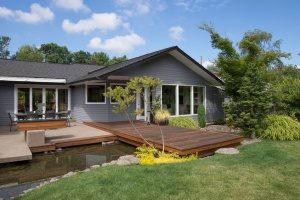 If you’re looking for a new project to start on in your backyard, look no further than a floating deck. Floating decks aren’t extremely hard to build as long as your willing to put in the time and effort to ensure that each step is done properly. A floating deck can add a simple, elegant design to any backyard while also creating useable space for things like outdoor furniture and grilling.
If you’re looking for a new project to start on in your backyard, look no further than a floating deck. Floating decks aren’t extremely hard to build as long as your willing to put in the time and effort to ensure that each step is done properly. A floating deck can add a simple, elegant design to any backyard while also creating useable space for things like outdoor furniture and grilling.
The key design element to create a floating deck is to have it be just a few inches above the ground, rather than being flush with grass. This slight elevation is what gives the deck the appearance of “floating”. Not only is this an aesthetically pleasing touch, the additional few inches actually creates a great vantage point to view the entire backyard. Building a floating deck is only going to require a couple of materials which include fill dirt, blocks, deck boards, and nails. Reach out to a fill dirt contractor to schedule your fill dirt delivery because using fill dirt is essential in completing the first few steps of building your new deck.
Deck Preparation and Site Leveling
The very first step in building your floating deck is determining where you want the deck to be placed and the exact dimensions of the deck. Mark the dimensions of the deck with either stakes or string. You have to make sure that the land your going to be building the deck on top of is level, firm, and stable. First, you need to remove any grass or rocks that may be in that area. Next, you have to deal with the dirt that is left behind. Only a lucky few are going to have this naturally occurring flat yard that is stable enough to support a floating deck, so it’s very likely you’re going to require the assistance of fill dirt.
Fill dirt is taken from below the top layer of soil so that it doesn’t contain any organic matter. Organic matter in dirt makes it nutrient-rich and great for farming, however, the organic matter makes the dirt unsuitable for construction purposes. This is because as the organic matter breaks down over time which will cause the dirt surrounding it to shift. Fill dirt doesn’t contain the organic matter, which means that when it is compacted, you can rely on it to be sturdy and stable.
To create level ground you’re going to have to determine what height is “level”. Then, you have to cut away any dirt that is above your level height. Following this, you fill in any low points with fill dirt so that they reach the level height. Next, you’re going to take fill dirt and cover the entire area the deck is going to be resting on. A good inch or so of fill dirt should do the job. Following placing down the fill dirt, you need to compact it. There’s nothing fancy about this step, you can do it with your hands and feet if you want. Or you can get a flat wood board to lay down overtop the dirt and apply pressure. The board will help you to cover more area in less time.
Creating the Base Structure
 Now that you’ve created a strong, sturdy and level base, you’re actually going to have to place down footer posts which will support the deck. Make sure you select the locations of the footer posts carefully because you’re going to have dig holes to place them in. Once you place the footer posts in the hole, you need to fill the hole up with concrete to ensure that the footer posts aren’t going to go anywhere. Next, you have to attach your main floor joists to the footer posts. After this, you need to attach the exterior and perimeter boards. Make sure for the exterior boards that meet at a corner, that you cut them at a 45-degree angle where they meet to create a cleaner look. The final step in creating the base structure is to place the interior supports. They can be attached to the outer frame by using brackets to make the junction between them even sturdier.
Now that you’ve created a strong, sturdy and level base, you’re actually going to have to place down footer posts which will support the deck. Make sure you select the locations of the footer posts carefully because you’re going to have dig holes to place them in. Once you place the footer posts in the hole, you need to fill the hole up with concrete to ensure that the footer posts aren’t going to go anywhere. Next, you have to attach your main floor joists to the footer posts. After this, you need to attach the exterior and perimeter boards. Make sure for the exterior boards that meet at a corner, that you cut them at a 45-degree angle where they meet to create a cleaner look. The final step in creating the base structure is to place the interior supports. They can be attached to the outer frame by using brackets to make the junction between them even sturdier.
Decking Boards
Once the base structure of the floating deck has been made, it’s time to focus your attention on the deck boards. This includes figuring out how many you need and cutting them to the appropriate size. You need to stain and seal all of your deck boards at this stage because you have to make sure that you’re getting the ends of each board. You can make things a little bit easier for yourself by buying a stain that also contains a sealer so that everything can be done at once, otherwise, you will have to seal your boards once the stain has dried. The final steps to building your floating deck are to lay down the deck boards. Take your time with this step as you want all of your edges to be clean and crisp; this is the part of the deck this is visible. Not only do you have to make sure that they are properly attached, but you also want to consider appearance. For example, your deck boards could run horizontal, vertical, or diagonal.
When you’re nailing the boards down, consider how the deck is going to be used. It’s likely going to be a place of leisure, so there is the potential for people walking around barefoot. Keep this in mind as you are placing nails because you wouldn’t want anyone to accidentally get hurt on one that’s not nailed down enough.
Final Steps
Your floating deck is now complete! Your final steps are to furnish it and decorate it how you please. An additional step you can take with your floating deck is placing some fill dirt around the perimeter of the deck. It doesn’t need to be a lot of fill dirt, but just enough to help prevent tons of rainwater running under your brand new deck. This will ensure that your floating deck lasts as long as possible. You can cover the fill dirt with some topsoil so that plants and grass can grow, but you’ll know underneath you have reliable fill dirt to protect your deck. Reach out to a professional fill dirt contractor to schedule your fill dirt delivery for your new floating deck project.









































